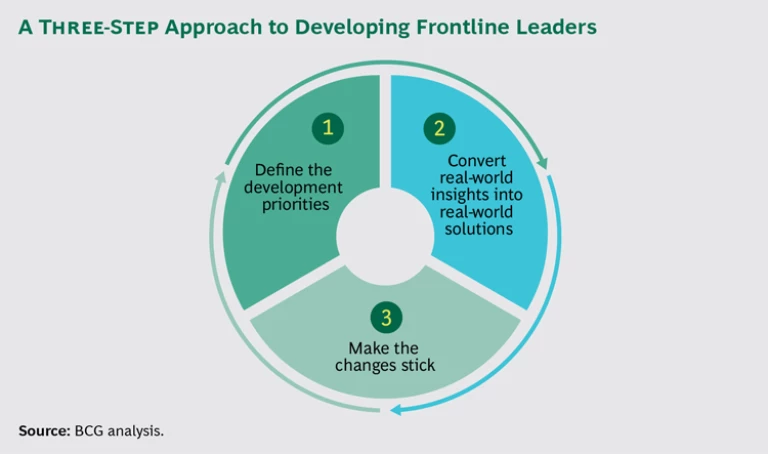Imagine this scenario: Josh, one of the top-performing employees in a key division of your company, gets promoted to his first management role. Josh is excited by the trust you’ve put in him, not to mention the pay increase and opportunity to oversee a team. But he’s also nervous because he’s never managed employees before. The company provides him with some training sessions, including a quick “welcome to management” meeting and a few online modules, which he’s supposed to pull up when he has specific questions. The trouble is, most of the modules seem disconnected from his real work. They’re based on abstract concepts with little or no connection to the daily challenges he faces.
Within a few weeks, Josh is flailing. Quality ratings in the unit are dropping, and his team is behind on a key project. Still uncomfortable in his new role, Josh reverts to what he knows best: he steps in to fix the problems and rescue the project, hoping that the people on his team will see what he did and learn from the experience. But on the next big project, the same thing happens—and then it happens again. Rather than leading his people, Josh continually has to bail them out. He’s buried under new administrative responsibilities and pressure to hit his numbers, and his team isn’t getting any better. In just a few months, he’s gone from outstanding employee to terrible frontline manager.
Companies spend a tremendous amount of time and money on leadership development for their executives. But they often fall short when it comes to developing their frontline managers, a larger group that can likewise have a significant impact on a company’s performance. These are the people who are one or two layers above frontline employees. They are new to management—in their first or second role overseeing teams—but they run core activities in the company and directly affect customer interactions. They are the primary face of leadership for the majority of the workforce. As a result, they have a tremendous impact on productivity, employee engagement, attrition, and customer satisfaction. Moreover, frontline managers serve as a talent pipeline for senior leadership roles in the company.
Effective development of frontline managers requires a new approach. Rather than offering broad-based, conceptual training, companies need to identify specific priorities for these leaders; in addition, they need to offer real-world tools and solutions that can be incorporated into managers’ daily and weekly routines, and they need to reinforce the approach through broad organizational support. For companies that get this right, the reward will be more confident frontline leaders, more productive teams, more satisfied customers, a more agile organization, and a huge boost in financial performance for the company overall.
Forgotten Masses
Who are frontline leaders? A deli department manager who oversees a team of prep cooks and meat slicers. A financial services manager who has moved from processing data to leading a team of six. A shift manager on a mining site. These people have recently been promoted from “doing,” as individual contributors, to “leading,” typically because of their technical expertise and high productivity. Instead of being responsible for their own output alone, they now manage others—often for the first time—and their day-to-day success requires a completely different set of capabilities. It’s no exaggeration to say that this is probably the biggest shift they will face in their careers, and one that many people find uncomfortable at first.
Despite the magnitude of the transition, frontline leaders are underserved by their organizations. A recent survey found that although they make up or influence 80% of the workforce, these managers receive only 20% to 30% of a typical company’s leadership development efforts. And many of the programs that do exist to develop frontline leaders are ineffective. Companies typically list some generic competencies that managers need to have, like communication or problem-solving skills, and then build a training program with workshops and e-learning to help close the gap. This approach lends itself to solutions that are often far too theoretical and that don’t apply to the daily challenges that frontline leaders face.
Without the tools they need to become better managers—and help their teams become more productive—many frontline leaders understandably revert to the behaviors that feel most comfortable to them. If your team is not performing well and you’re directly responsible for its results, you can solve that short-term problem by relying on what you’re good at—the technical expertise and productivity that got you promoted in the first place. It’s like coaches who, in tight games, can’t resist putting on a uniform and running onto the field. But that doesn’t help them become effective leaders, and their team doesn’t improve either, resulting in a vicious cycle.
Companies need to change their perspectives on development. They need to move away from “training” as the solution and instead focus on understanding what their frontline leaders do every day, week, month, and year. They need to embed development into frontline managers’ everyday work and routines. And they need to make improvements sustainable by addressing the context in which these managers work, making it easier for them to do the right things. Our experience working with clients suggests that an effective frontline leadership development program involves three steps. (See the exhibit.)
Step One: Define the Development Priorities
At many organizations, there’s a long list of areas in which frontline leaders can improve—which is understandable, given how new they are to management. But addressing all of them would be overwhelming and counterproductive, so companies need to identify the two or three that are likely to have the biggest impact on performance. They can find this out from the managers themselves, using tools that we call “development lenses.”
Identify and shadow top performers. You probably already know who your best performers are by reputation and from annual reviews. Engaging with them in focus groups, shadowing them as they work, talking to their teams and managers, and comparing them with average performers will highlight what your best frontline leaders are doing differently. How do they handle challenging situations with their teams? By collecting and synthesizing these insights, companies can identify what “good” looks like in their frontline managers, determine what those who aren’t performing as well do differently, and begin to codify specific practices to close the gap.
Track how frontline leaders spend their time. A second way to define priorities is to ask a wider group of managers how they spend their time each day. By breaking down the workday and tracking leaders’ activities, companies can start to spot trends. For example, is a manager spending more time doing the team’s job than leading the team? Is he or she spending a lot of time on unproductive activities like paperwork? Compiling this data across different groups of frontline leaders will identify priorities that the company can address. In addition, understanding how these leaders spend their time allows the company to identify points in the workday where new capability-building measures can be added. (See “A Financial Services Firm Helps Its Frontline Leaders Get Back to Basics.”)
A FINANCIAL SERVICES FIRM HELPS ITS FRONTLINE LEADERS GET BACK TO BASICS
A back-office unit at a financial services firm presented a big challenge for frontline leaders. The unit was responsible for processing and integrating thousands of inputs, error free and on time. In such a pressure-cooker environment, these managers were in a constant scramble to hit daily deadlines. Employee engagement and morale were low and turnover was high—creating a vicious cycle of poor performance and overtaxed staff. Complicating matters, the overall organization had made major changes to its operating model in the past five years in order to reduce costs and redefine the business. But the development program for frontline managers consisted of a set of self-service webinars that saw little use.
To understand the root causes of these problems, the company asked its managers to track their activities during the workday. The results showed an extremely frenetic pace, with managers constantly bouncing back and forth between activities. They spent far more time doing their teams’ work than leading their teams. They had little opportunity to develop staff—something that could make the teams more efficient over time. And because their activities were so fragmented and frequently interrupted by unexpected urgent requests, managers were constantly sprinting to keep up. Some received several hundred e-mails a day.
The company decided to build specific capabilities in two critical areas. First, to improve time management, frontline managers were taught to delegate projects that could and should be handled by their staff. That freed them up to stop periodically throughout the day to think about how they could better meet customer needs. Similarly, every morning, managers spent ten minutes organizing their day, followed by 15-minute check-in meetings with teams to clarify priorities. The company even instituted basic e-mail procedures, such as having managers turn off their accounts for several hours at a time and then respond to everything in their inbox in one consolidated burst.
As these measures began to take effect, the company asked its frontline managers to allocate their newly freed-up time to developing their teams. At monthly one-on-one feedback sessions, managers identified the strengths and weaknesses of individual employees. They also logged their development priorities and tracked their progress between meetings. Fostering a team-oriented culture helped improve the unit’s performance in a systematic way.
Managers learned the basic principles of all these measures in workshops, practiced applying them for ten days at a time, and then met to share and refine what they’d learned. As a result, they became more effective and confident as leaders. Employees developed a broader set of skills, making them more self-reliant and engaged. And the unit’s overall productivity increased—with better on-time performance and increased accuracy—which, in turn, led to more satisfied clients.
Map the stress points in their work lives. Look at the stress levels that frontline leaders experience when they perform specific activities. For example, they may feel anxious about establishing credibility. They may not enjoy standing up in front of their teams and discussing productivity goals. They may wonder what their employees really think of them and subconsciously try to be liked rather than respected—leading to performance problems. By analyzing these stress points and identifying what the best leaders have done to overcome them, companies can begin to understand and address their root causes. Do these problems affect only a handful of managers? Do they point to more widespread organizational issues? Can the company put measures in place to help managers deal with these stress points?
Identify routines and points in the workday that are critical to performance. Helping frontline leaders prepare for important routines and specific moments in the workday will dramatically improve their confidence and productivity. For example, in one company, shadowing managers revealed that the best performers were holding meetings every morning with their teams. These managers were asked to design the ideal morning meeting and develop a training program with supporting tools and checklists to help other frontline leaders adopt similarly effective routines. In that way, the company helped spread the practices of top performers, and those meetings became key anchor points for learning.
Step Two: Convert Real-World Insights into Real-World Solutions
Armed with these real-world insights about your frontline leaders—top performers and underperformers alike—you can begin finding real-world solutions. Like the first step, this process differs from the traditional approach to leadership development, which is often too theoretical for practical use. Nor does it pull people away from their daily job responsibilities in order to learn things that may or may not help them solve real-world problems.
Translate change into new routines and rhythms. The most effective tools and solutions for frontline leaders are woven into their daily work. Think about people trying to get in shape. They may find it really hard to get up early in the morning to work out. But by taking the stairs instead of the elevator or walking to lunch instead of taking the shuttle, they can make fitness a part of their workday. The same is true with capability-building programs. Companies should identify the opportunities to build new behaviors that arise every day, week, and month. (See “An Industrial Company Improves Productivity Through Frontline Leaders.”)
AN INDUSTRIAL COMPANY IMPROVES PRODUCTIVITY THROUGH FRONTLINE LEADERS
The new CEO at an industrial company had a mandate from his board to boost productivity, and to do so without a major capital investment. As a first step, he analyzed the corporate culture and quickly concluded that the company was highly process-oriented and built on top-down directives. Managers tended to give very prescriptive guidance to employees rather than seeking their input, and people were rewarded for simply following orders. That culture was hindering innovation. To deliver on his mandate, the CEO needed to improve the way frontline leaders managed their teams and solicit bottom-up ideas that could boost productivity.
With these goals in mind, he launched a transformation aimed at building the capabilities of frontline leaders in several key areas. The idea was to rely less on top-down tasks, increase the dialogue between managers and their employees, spur new ideas, and make sure that both groups understood the potential financial impact of their decisions. Rather than relying on theoretical training programs, the company opted to address the work of managers in practical and tangible ways.
For example, the company restructured the morning meetings that frontline managers held with their units every day, allocating time to solicit employees’ opinions and ideas and not just issue orders. Managers also received simple tools such as checklists, feedback mechanisms, and learning guides to help them stick with the new target behaviors. One-on-one meetings between managers and team members helped address the development needs of individual employees. And regular, real-time feedback helped managers make steady progress.
To ensure that the changes were sustainable, the company measured employee engagement, the number of coaching and feedback conversations held, and even the use of digital tools—downloads of capability-building tools, for example, and the frequency with which they were used. The company used these metrics to identify which measures were having the biggest impact on manager performance and overall company results.
After an initial pilot, the company made some refinements and rolled out the program on a larger scale, training 6,000 line managers across 18 countries in three languages. With these new management capabilities in place, employees were far more empowered to make suggestions, and managers had a much clearer sense of how to evaluate those suggestions. Overall, the development process for frontline leaders was part of a larger improvement program that unlocked more than $1 billion in new value.
For example, rather than making managers sit through a training module about communication skills, you can develop these skills during the ten-minute morning meetings that they hold each day by giving them a checklist of items to cover. Or you can make one-on-one discussions with team members part of frontline leaders’ weekly or monthly routines. Then you can give them the specific tools they need to make these routines more effective, such as checklists, daily and weekly schedules, mobile apps, and sample scripts to help them provide feedback to employees. To be clear, training can still be valuable, but it needs to be part of a broader set of tools that can be directly incorporated into day-to-day work and responsibilities. (See “The Value of Cross-Training.”)
THE VALUE OF CROSS-TRAINING
Just like athletes, frontline leaders benefit from a variety of training methods. In addition to daily routines, options include the following:
- Coaching and mentoring, such as by peer groups, one-on-one mentors, and subject-matter experts
- Job programs and rotations that provide access to different business units and geographic regions, along with the opportunity to serve on task forces and gain experience with stretch roles and different career paths
- Structured and unstructured feedback, including check-ins from supervisors after large projects wrap up, awards, rewards, annual performance reviews, and 360-degree feedback that is solely for the manager’s benefit and doesn’t become part of a formal evaluation
- Formal training in new concepts and skills, such as on-demand e-learning, workshops, learning paths for specific roles, conferences, and visits to other organizations
Rely on internal experts. A benefit of tapping into top-performing leaders to identify priorities and design a development program is that these people can serve as trainers and coaches for their peers. Their suggestions invariably come across as more authentic and “homegrown,” rather than imposed from above. A secondary benefit is that it gives these employees recognition for their accomplishments, and it shows others that the company rewards excellence. These leaders, forming a working team of internal experts, should be involved in every step of the process as coaches, advocates, and champions of change. Another approach is to ask those who directly oversee frontline leaders to share their own practical experiences.
Design solutions for scale. Companies should start with an initial pilot in a single business unit or department, refine it based on results, and then roll it out to the rest of the organization in waves. Throughout that process, the working team of internal experts can grow through a learn-do-teach approach. For example, the frontline leaders in the second wave can become coaches and trainers for those in the third wave. Also, any solution the company implements needs to be scalable from the start. Frontline managers are a large cohort at any sizable organization, and tools that are too time-consuming or resource-intensive won’t lead to real change.
Use technology to support the changes. Digital tools can help companies implement these changes. For example, some organizations give managers a mobile app that provides reminders about how to run a meeting—for example, highlighting the need to explain the rationale behind tasks, ask for feedback, and encourage collaboration. Apps can also help frontline leaders manage their time—with calendars, checklists, and alerts—and solicit feedback on their own performance. In addition, if managers seem to be overwhelmed by information coming at them from multiple sources, technology can help companies organize and deliver it in a more structured and digestible way.
Step Three: Make the Changes Stick
Frequently, the gains from development programs are short-lived, so companies need to take steps to ensure that they are sustainable. This often hinges not on the tools and solutions themselves but on the way they’re rolled out.
Consider the context. Changing the behavior of frontline managers often means addressing structural issues that affect the way they perform, meaning that the required intervention involves a change in the organization. (See “A Retailer Taps into Frontline Managers to Improve the Customer Experience.”) For example, a hospital might tell its frontline leaders that all patients must have a superlative experience. But if it pays them bonuses based on patient volume—that is, on speed rather than on customer satisfaction—it is sending a mixed message.Companies can also use formal and informal rewards to reinforce new behaviors. For example, a hospital might showcase a family’s thank you note at weekly meetings and celebrate the team that cared for the patient. Changing the context makes it easier for managers to take the initiative and do the right thing, without requiring their supervisors to ask them to do it each time.
A RETAILER TAPS INTO FRONTLINE MANAGERS TO IMPROVE THE CUSTOMER EXPERIENCE
A large retailer had strong operational processes and a culture focused on employee metrics, but it needed to improve the customer experience and employee morale. All this required new behaviors and priorities on the part of frontline leaders. In the past, these managers had been promoted because of technical expertise, not necessarily because they were good leaders. There was insufficient emphasis on coaching or development, and many managers assumed that their job was to continue doing what they’d always done.
The company decided to give managers far more latitude to work with their teams in order to create a better customer experience. In part, that meant streamlining their administrative responsibilities, which freed them up to spend more time “on the floor,” interacting with customers and employees. Managers were encouraged to think about their roles differently and take advantage of opportunities to work one-on-one with team members. Sometimes this meant working a register alongside another employee or role modeling the small but meaningful interactions that are so important to the overall customer experience. The company also changed the way managers coached employees. Rather than focusing on problems that needed to be corrected, managers were asked to celebrate successes in both one-on-one sessions and team meetings.
To ensure that the changes would stick, the company standardized the priorities and responsibilities for each job category and created new routines that laid out a comprehensive view of what managers were supposed to do each day. As one department manager put it, “I realized that my role isn’t only to do my daily tasks. It’s my role to be a leader. [And] I spend my time training the employees in my department to become leaders themselves.”
After a pilot, a team of top-performing store managers who had participated in developing the initiative helped roll it out to a wider network of stores. Midway through the rollout, the initiative had already led to strong improvements in employee engagement, customer feedback, and financial performance.
Spur change from the top. Senior executives should serve as role models, which often means changing their own behavior to align with the objectives of the leadership development program. For example, if you ask frontline leaders to spend more time coaching their team members one-on-one, then senior managers must do this too. Senior leaders should ask frontline managers who their best and worst performers are, what he or she is doing to develop them, and how the senior leader might help. And they should ask them about the impact of the program and regularly report on what they hear at their own leadership meetings. This type of “reverse cascade” reinforces the alignment between senior executives and frontline employees.
Continuously improve. Organizations should measure the impact of their development initiatives by looking at what their frontline leaders are doing differently from what they did in the past. For example, how much have they shifted from doing to managing? How do their teams feel about them? How has customer satisfaction or team productivity changed? Based on these metrics, companies can refine the program over time.
From Outstanding Employee to Outstanding Leader
By taking the time to understand how frontline leaders work and the problems they face, and by providing them with real-world solutions and embedding the necessary changes into the organization, companies can turn this cohort into an asset that will help more engaged teams increase productivity and deliver a better experience for customers. Moreover, it will allow them to build up a bullpen of internal talent that will eventually become the company’s midlevel managers and ultimately its senior leaders.
Imagine that on his first day as a manager, Josh (from our opening scenario) is assigned a guide who breaks down each day and week into specific activities, such as coaching team members, administration, and troubleshooting. Imagine that he also receives a set of proven tools that his peers have developed and use themselves to support the managerial routine, including sample agendas for team meetings and ways to solicit real-time feedback on his own performance. An app helps Josh stay connected with supervisors and track the needs of his team members—their goals, concerns, and developmental priorities for the coming week, month, and year. If he has a question about a specific aspect of management—say, the best way to teach an employee a new technical skill—he can access via his smartphone a training module developed by his peers, complete with the names and contact information for experts whom he can call on afterwards with additional questions.
Josh also has a mentor who’s a few years ahead of him and available to talk through any problems that arise. Occasionally, this person will shadow him for a morning, identifying any areas where Josh could improve. Periodic workshops allow him to role-play difficult scenarios risk-free. Throughout, Josh receives real-time feedback from his team and peers about what he’s doing right and what needs work.
The end result is that, instead of trying to fight fires every day, Josh is now a confident leader running a high-performance team. His people get the development they need—confirming that the company is investing in them—and he’s being groomed for a more senior role 18 months out. If the company needs to adapt its strategy, executives can quickly translate new goals into specific measures that cascade down to leaders like Josh—and ultimately to frontline employees.
Imagine what you could accomplish with a few hundred frontline leaders like Josh.
Acknowledgments
The authors are grateful to Simon Bartletta, Caroline Blanch, Grant Freeland, Rebecca Gill, Sagar Goel, Karin Hinshaw, Hana Lane, Jonathan Lim, Grant McCabe, Mukund Rajagopalan, Rebecca Russell, Rachel Scott, Jon Swan, Nicholas Ward, and David Welch for their contributions to this report.






